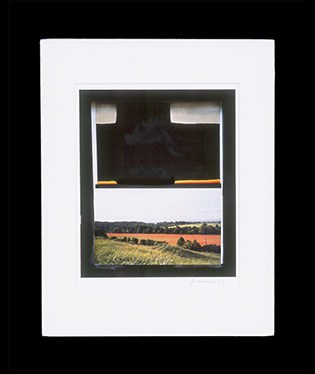Portrait of an Artist — page 3
Stebbins Gallery in Cambridge, and she was a National's Competition Finalist at the Provincetown Art Association & Museum. Her work also hangs in numerous private collections across the country and in England.
Motherwell's current series of collages incorporates the image of a window allowing both a literal access into the pictorial surface and a metaphorical entrance into the affective 'self' of the artist. "Psychologically, the window is a symbol of looking into how I see the world," she reveals. "All the imagery I've been using has a window effect. There was a window in my studio in Provincetown where I worked for more than 30 years. It's etched in my mind. I don't think it was a conscious choice." Motherwell explains that she began with a 1929 painting by Georgia O'Keefe entitled "Black Cross, New Mexico." In this work, a large black cross almost entirely covers the foreground of O'Keefe's canvas and bisects the lower half of the painting, which is enveloped in roiling cloud formations and crowned by thin horizontal stripes of sunset yellow and orange. Motherwell scans the upper-half of this painting, so that the black horizontal bar of the cross assumes the image of a raised window, the thin stripes of orange and red neatly dividing the pictorial surface in half. In the lower half of her open windows, she applies photos and other cut images appropriated from disparate sources—carnations, fields of poppies, trees.
Motherwell's initial window, entitled appropriately enough, "Georgia on My Mind," includes a shadow-box black frame that she also scans for other works in the series. "Georgia O'Keefe has been a powerful influence over the years," explains Motherwell. "The image of the cross is hers, and I merely expounded upon it. The depth of the frame mirrors its sacred nature. I scanned the original collage with the frame and reproduced the image for others in the series. I keep finding new things to do with it. I'm sure it has to do with the view from my studio in the East End. The windows are a way of seeing into my mind. The work reflects what goes on in my life."
"Black and white have always been very important to me," Motherwell states. "Black is my favorite, and the contrast of black and white is a recurring theme in my work. But I love the idea of having a little color say a lot. When I did "Georgia on My Mind," the oranges and yellows really impressed me. I am particularly intrigued with paintings that have small daubs of color suggesting a much larger area. Color lends an uplifting, hopeful sense to my pieces. My intention is not to equate black with depression and sadness."
The incorporation of realist imagery with abstract configurations is also carried over in Motherwell's

"Window: Poppies" collage
"Rosetta" collages. She explains that the series was "named after a woman named Rosetta, who was my boyfriend's grandmother. He had photos of her from the 1920s, and I was struck with her eyes. Either her face or body or both are in all the Rosetta works." The compositional structure of the Rosetta series is referenced from another of Motherwell's favorite artists, John Singer Sargent, whom Motherwell admires for his use of black in his paintings. In works in this series like "Sentimental Journey" and "Japanese Daydream," the mixture of collaged material and a light wash of paint lends an ethereal watercolorist translucence to the imagery.
As with the Window series, the Rosetta collages are contained within a shadow box. "I like the 3-D shadow box effect," explains the artist. "Doing collage is a physical, textural thing. Originally, the shadow box idea was a way to draw you into the window effect. I liked the way the frame cast shadows at different times of the day. I like the idea that it makes it more of an 'object.' When I'm framing something, I know what I'm looking for without being exactly able to articulate it. It's like how you know when a painting's done—when you've 'hit' what you need to hit. I don't want an elaborate picture frame. I want it to be part of the piece."
Reflecting on the evolution of her astonishingly beautiful work, Motherwell says, "I think there's going to be more painting and less collaged imagery in the future. I think I want to work with the collaged work looking more like a painting. It's going to be really interesting for me this summer, since I'm not living on the water in Provincetown. I'm interested in how this will be reflected in my work. When you're doing non-figurative work, you don't know what your desired end result will be. It evolves. You hope it works. And when it's done, you know it."

Recent Comments